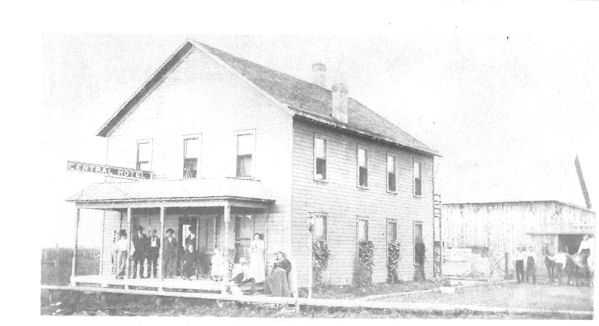Palo Alto, Echo and Oakville
The story of three towns
By Connie Street, based on the book Oakville … 100 Years Relived by JoAnn Murray.
OAKVILLE, Iowa - Oakville wasn’t the first town built near the Iowa River in Eliot Township.
The small town of Palo Alto, which consisted of a post office that was established in 1848, several houses, a church, and a school, was located about one-quarter mile south of today's Oakville.
In 1868, the northwest area of today’s Oakville was known as Tater Island. No explanation for the name has been proven. Some believe the area was shaped like a potato, others wonder if the ground was perfect for growing spuds.
In the early 1880s, a new town was established after a railroad was built north of Palo Alto. The railroad was the demise of Palo Alto. Legend says the new town was first called Echo because of the sound of the train whistles echoing off the nearby bluffs.
Charles W. Edwards and Joseph H. Creighton are credited with choosing the name Oakville in early 1884. They were reportedly standing near a young burr oak tree at the time. Creighton moved his general merchandise store and his family from Palo Alto to Oakville in January 1885. It was the first building in the town of Oakville.
Abe and Harry T. Parsons laid out Oakville, which consisted of three blocks containing 35 lots, on Dec. 11, 1891, where the Iowa Central Railroad and the Missouri-St. Paul Railroad crossed.
The first 50 years of Oakville were filled with enthusiastic growth and progress.
A grain storage elevator was established in 1895. Fires destroyed businesses in both 1898 and 1899. Today, TriOak Food, which might be called the descendant of the first elevator, is the largest employer in Oakville and the surrounding area.
Also in 1895, the Oakville school was built and Miss Izola Sweeny was the first schoolteacher in Oakville.
| The Methodist church, built in 1890, was moved from Palo Alto to Oakville in 1896 and is still a part of the Oakville Methodist church building
| |
Oakville was incorporated Sept. 30, 1902, the same year the telephone came to town offering its service for $1 per month. Oakville telephone companies were Louisa County Air Line Co., Oakville Telephone Exchange Co., Farmer's Mutual Telephone Co., Oakville Mutual Telephone Co.
In the fall of 1909, a new brick school building was constructed. Wesley Emmett Carter was the first student to graduate from the Oakville High School in 1909. Two years later there were 104 students enrolled in the Oakville School District. The last class, with eight students, graduated in 1961. Oakville and Wapello school districts consolidated in 1962.
| The Central Hotel and Livery Stable, built in 1896, escaped the fires that destroyed several businesses in both 1898 and 1899. The livery stable was torn down in 1927. Legend says a man was killed in the stable when a horse kicked him and his spirit haunts the nearby hotel, more recently a restaurant/tavern. The photo at right is the hotel (more recently a bar/restaurant) after the 2008 flood. |  |
The Russells were one of the early Oakville families. The Russell home was the first built by Sam Creighton, who had invented a machine that made concrete blocks. It still stands, but was damaged when flooded in 2008.
The Iowa River had flooded through the years, however none of the floods were as devastating as the one that topped the levee and spilled into the town on June 14, 2008. The population of about 440 is expected to go down dramatically, since many of the residents are seeking homes on higher ground.
Previous documented serious floods in the Oakville area include 1851, 1858, 1862 and 1881. A levee was built in 1887, but the Iowa River water broke through in 1946 because of an ice jam. About 400 homes and 13,000 acres of farmland were engulfed, which reportedly rose to 11 feet above normal before temperatures plummeted and the water froze.
Automobiles, including Fords, Studebakers, Flanders, Hupmobiles and Whippets, were first seen in Oakville in 1907.
The last freight train pulled through Oakville in November 1971. The once busy business district diminished, leaving only a few businesses including a general store, two service stations, a tavern, barber shop, café and a bank.
The town is still in existence and had a population of about 440 when the worst flood on record topped the levee in June 2008. At this time, it is unknown how much of Oakville will be rebuilt.